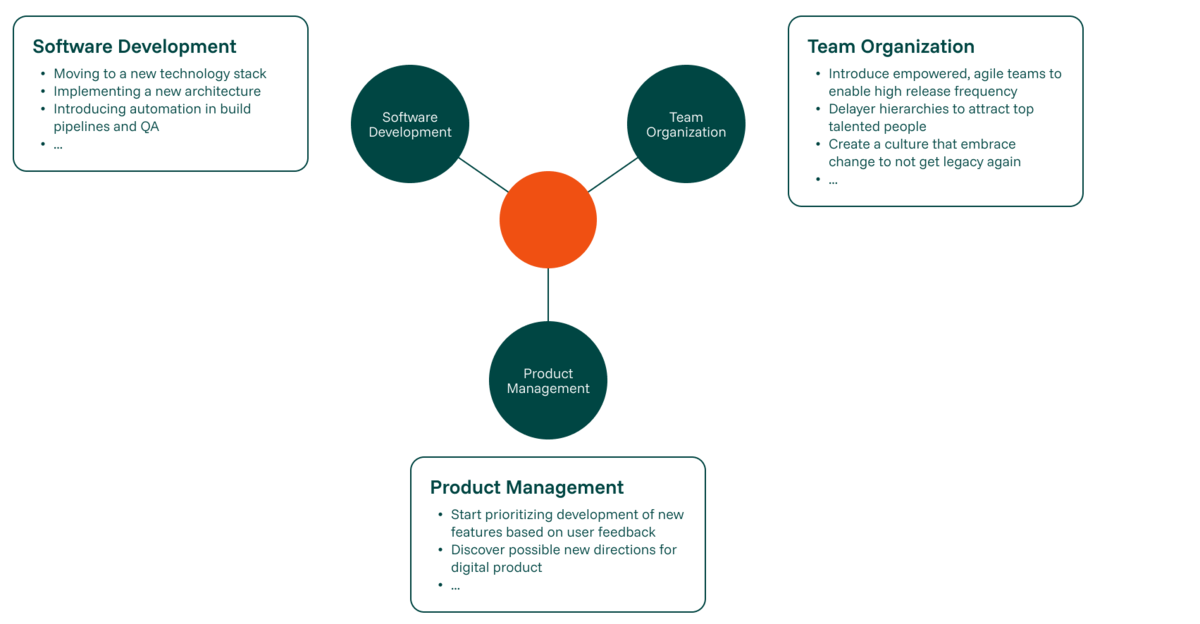Legacy-IT-Migration
Legacy IT systems slow down innovation and efficiency. Qvest helps businesses modernize outdated software, optimize workflows, and attract top tech talent. With a structured approach, we align IT and management to ensure smooth migration. Discover how a modern tech stack can transform your business.

IT is not a new thing
Many companies are running central custom-built IT systems that are quite old, worked well but struggle to fulfill modern requirements like short release cycles or modern user experience. Deciding to modernize a legacy IT system is hard and the options how to modernize are vast. We can guide you to through this process and help you to modernize complex legacy software systems.
What are legacy IT systems?
With legacy IT systems we mean custom-built software systems that would no longer be developed under today's circumstances because of:
- The chosen technology stack
- The integrated standard off-the-shelf products
- Changed regulatory requirements
- Changed customer needs
- A new and more competitive business environment.
So legacy does not only mean old technology. Also software systems built on modern technology stacks might be legacy if business parameters have changed.
Modernizing a legacy IT system can be a big boost for your company!
A modern technology stack gives you the possibility to integrate with new technologies like generative AI providers that can help boosting your organization's productivity.
An IT system architecture that allows for a modern software development process leads to shorter release cycles and therefore shorte time to market for new features.
Modern IT systems allow for automation in the software development process. Your staff can focus on creating value instead of spending time on repetitive tasks.
Modern modular software architectures allow for scaling of single modules and more flexibility in runtimes.
Attract top technology talents with a forward-thinking technology stack. Support your business processes with a modern and motivated IT team.
Migrating legacy IT systems is more than a technology update
Migrating a legacy IT system means more than writing source code and setting up a new runtime environment. Finding a good technology stack and architecture is important. But besides the update of the tech stack there often is also need for updating the software development process to allow for more frequent releases. Agile methodologies are needed. Upskolling your software team for the new technologies and methodologies is a big part of migrating a legacy IT system.
Another challenge is the product management. In legacy IT organizations there was often no differentiation between software development and product management. The question WHAT do build was made by the same people that answered the question HOW to build it. In modern organizations product management is a profession of its own including market research, getting early user feedback and priorising the most promising features for the next development phase.

Bringing all perspectives together
The motivation for modernizing a legacy IT system is often a technical one. The software team knows best about risks and implications of legacy systems. These risks are often not obvious to non-technical people and hard to communicate. Management decides on trade-offs between developing new features and investing in modernization.
With our deep background in software technology, product management and business use cases we are able to bring together management and IT to align on the need and priority for modernization.
Our step by step approach
Modernizing a legacy IT system looks like a big invest. So the decision is not easy to make. Our step by step approach helps you analyzing the situation of the legacy IT system, finding options for migrating and making the right decision.

With our knowledge in software development, technology consulting, agile consulting and product consulting we can help you handling all challenges of migrating a legacy IT system.
In 5 steps spanning about two months we guide you to finding the right way to migrate your legacy IT system.













